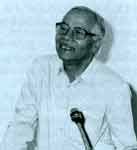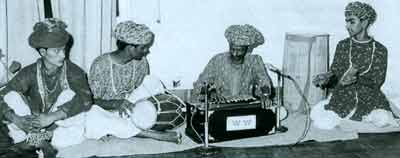

Haryali Teej in IGNCA
HARYALI TEEJ –This year Janapada Sampada celebrated its Foundation Day. Haryali Teej, which falls on Shukla tritiya (in the Hindi month of Savan), in a different way. Haryali Teej heralds the arrival of the rains as a sign of happiness, prosperity and love. In Roman Haryali Teej is known as Madhusravani. The J.S. division on this occasion initiated a `Study Circle’ where researchers and scholars can exchange views, share their ideas and fresh research findings. It is a forum where professors and beginners from Universities in and around Delhi can discuss academic matters. In the first sitting of the Study Circle, researchers from Delhi University, Jawaharlal Nehru University and Jamia Milia Islamia University participated.
The idea of a Study Circle was mooted by Member Secretary IGNCA, Prof. N.R. Shetty, who also inaugurated the first meeting on August 8. Speaking on the occasion, he announced that the `Study Circle’ would meet regularly and involve itself in academjic issues. Research papers read by the scholars would be published by the IGNCA in the form of monographs. Some papers would also be considered as research articles to be published in the proposed IGNCA Research Journal. He also invited the scholars to exploit the academic resources of IGNCA like the books, slides and microfilms for academic pursuits.
The meeting had a session on Folk Aesthetic and Identity. Five scholars shared their research methods, findings and experiences. The themes of presentations included: (1) `Category of Folk’, by Dr. Roma Chatterji; (2) `Folk Aesthetics in Kannada Poetry’, by Prof. Shiva Prakash; (3) `Aesthetics of Yakshagana’, by Dr. Purushothama Bilimalae; (4) “Folk Aesthetics and Material Culture”, by Prof. Deepak Mehta, and (5) `Cult of Pabuji and identity’ by Prof. Vinay Kumar Shrivastava.
The Haryali Teej fell on August 11. The celebrations began with the worship of the nyagrodha (Ficus Bengalensis) tree. The Puja, conducted by Dr. N.D. Sharma was performed by Smt. Geets Rawat. This tree is a symbol of knowledge. Shri. Kailash Kr. Mishra, compering the programe explained the significance of nyagrodha or vat-vrks in the folk culture of India. The Vedas and other sacred scriptures mention it as a tree that manifests knowledge. Great Indian sages and scholars had looked upon it as source of wisdom. Nagarjun, a famous Hindi and Maithili writer, has given a wonderful account of peoples association with nyagrodha in his well-known novel Baba Batesharnath. The city of Badodara is named after this tree – a city situated in the lap of vat is Vadodara. It is a tree that spreads wide, with its branches growing roots downwards.
Dr. Molly Kaushal welcomed Professor Yogendra Singh, an outstanding Social Scientist and Professor Emeritus at Jawaharlal Nehru University, who graced the occasion with his presence as chief guest. Dr. Kaushal also welcomed Prof. N.R. Shetty, Prof. Indranath Chaudhuri and Prof. R. K. Bhattacharya, the new Professor and Head, Janapada Sampada.
In its essence the Haryali Teej is associated with the introspection and evaluation of the performance of the division during the year gone-by. Dr. Richa Negi gave a brief account of the various events, programmes and publications. She also talked about the in-house projects of all the scholars of the division and the recently concluded IGNCA-UNESCO-UNDP Project Village India: Identification and Enhancement of Cultural Heritage.
Under this project more than 80 villages of all the geographical regions of India were studied to identify development indicators for the planners, development professionals, Government officials etc. Dr. Negi informed about “Heritage Activity”, a new programme introduced this year. Under this programme scholars can undertake new innovative and needful projects to promote people’s concern to retain the tangible and intangible heritages of India. As part of this programme, interactions with schoolteachers, principals, planners, curriculum experts and educationists are being held to evolve a guide to include Heritage Activity as a regular, curricular, marked and evaluated subject for the schoolchildren from class 1 to 12.
Rajasthan has always been cradle of heroism and artistry. The villages and cities of Rajasthan are colourful and cheerful with music, dance and arts. The folk artists of Rajasthan are proud of their `ranga virango mharo pyaro rajasthan‘ (multi-colored, lovely and our own Rajasthan). A group of folk artists from Jaipur, presented the Ghumar dance with vibrant falsetto songs carrying the audience to the deserts of Western India. Ghumar as the name suggests is a dance that involves spin-movements. The dancers spin at a speed in dazzling coloured dresses, creating a rainbow effect. The dance conveys the spontaneous happiness that breaks out when the rain comes.
Professor Yogendra Singh admired the non-linear research activities of the Centre in his speech. He congratulated Member Secretary and research scholars for their efforts. He also expressed his concern about the vanishing trends of many cultural traditions of several parts of India and requested Prof. Shetty to undertake some projects to document most of these great heritages for the future generation and research communities.
Prof. Shetty, in his words of blessings, assured Prof. Singh that IGNCA would certainly take up some projects to document the vanishing heritages of India. He congratulated the scholars of the division for their efforts and expressed his hope that the division will come out with some more important, need-based, purposeful, unique time bound and untapped projects under the able guidance of the new Professor and Head,Prof. R.K. Bhattacharya, who honoured the folk artists with flowers and appreciated their performance. Shri Kailash Kr. Mishra presented the vote of thanks.
(Report complied by Shri Kailash Kr. Mishra)
[ Newsletter | List of Newsletter ]




